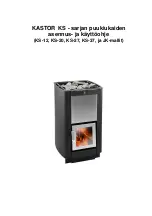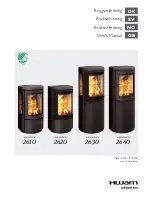
46
If the stove is fitted in place of an open fire then the chimney will require sweeping after a month
of continuous operation. This is a precaution to ensure that any “softer” deposits left from the
open fire usage have not been loosened by the higher flue temperatures generated by the closed
stove.
In situations where it is not possible to sweep through the stove the installer will have provided
alternative means, such as a soot door. After sweeping the chimney the stove flue outlet and the
flue pipe connecting the stove to the chimney must be cleaned with a flue brush.
Periods of Prolonged Non-Use
If the stove is to be left unused for a prolonged period of time then it should be given a thorough
clean to remove ash and unburned fuel residues. To enable a good flow of air through the appli
-
ance to reduce condensation and subsequent damage, leave the air controls fully open.
Extractor fan
There must not be an extractor fan fitted in the same room as the stove as this can cause the
stove to emit smoke and fumes into the room.
Aerosol sprays
Do not use an aerosol spray on or near the stove when it is alight.
Use of operating tools
Always use the operating tools provided when handling parts likely to be hot when the stove is in
use.
Refuelling on to a low fire bed
If there is insufficient burning material in the firebed to light a new fuel charge, excessive smoke
emission can occur. Refuelling must be carried out onto a sufficient quantity of glowing embers
and ash that the new fuel charge will ignite. If the fire bed is too low or cool, suitable kindling
must be used to re-light fires
Fuel overloading
The maximum amount of fuel specified in this manual should not be exceeded, overloading can
cause excess smoke.
Use with door left open
Operation with the door open can cause excess smoke. The appliance must not be operated with
the appliance door left open except as directed in the instructions.
Dampers left open
Operation with the air controls or dampers open can cause excess smoke. The appliance must not
be operated with air controls or dampers left open except as directed in the instructions.
Chimney Fires
If the chimney is thoroughly and regularly swept, chimney fires should not occur. However, if a
chimney fire does occur turn off the stove immediately and isolate the mains electricity supply
(if applicable), and tightly close the doors of the stove. This should cause the chimney fire to
go out. If the chimney fire does not go out when the above action is taken then the fire brigade
should be called immediately. Do not relight the stove until the chimney and flueways have been
cleaned and examined by a professional.
Permanent air vent
The stove requires a permanent and adequate air supply in order for it to operate safely and ef-
ficiently.
In accordance with current Building Regulations the installer may have fitted a permanent air
supply vent into the room in which the stove is installed to provide combustion air. This air vent
should not under any circumstances be shut off or sealed.
USER OPERATING INSTRUCTIONS
Please read the important notices given above before referring to the main instruction book for
detailed operating instructions.
Recommended fuels
Stoves may be designed to burn dry seasoned wood logs and/or solid mineral fuel as indicated in
the main stove manuals.
HETAS Ltd Approval
HETAS approval may be limited to specific fuel types as detailed in the main instruction manuals.
Approval does not cover the use of other fuels either alone or mixed with the recommended fuel,
nor does it cover instructions for the use of other fuels.
















































